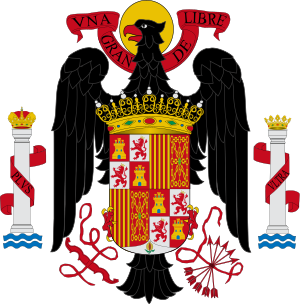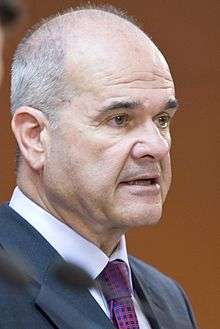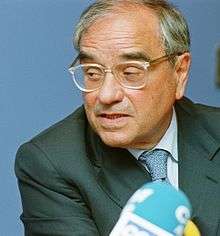Third Deputy Prime Minister of Spain
The Third Deputy Prime Minister of Spain, officially Third Vice President of the Government of Spain, (Spanish: Vicepresidente Tercero del Gobierno de España) is a senior member of the Government of Spain. The office of the Third Deputy Prime Minister is not a permanent position, existing only at the discretion of the Prime Minister. It is a constitutional office because it is foreseen in the Constitution when it provides for the possibility of existing more than one Vice Presidency.
| Third Deputy Prime Minister of Spain
Vicepresidente Tercero del Gobierno de España | |
|---|---|
.svg.png) | |
| Government of Spain Council of Ministers | |
| Style | Excelentísimo/a Señor/a |
| Member of | Cabinet |
| Residence | Palacio de la Moncloa |
| Seat | Madrid, Spain |
| Nominator | Prime Minister |
| Appointer | Monarch Countersigned by the Prime Minister of Spain |
| Term length | No fixed term No term limits are imposed on the office. |
| Constituting instrument | Organic Act of the State of 1967 (original) Constitution of 1978 (current) |
| Formation | 3 January 1974 |
| First holder | Licinio de la Fuente y de la Fuente |
Its existence is extremely rare, and proof of this are the few occasions in which it has been used: three times in the last years of the Franco dictatorship and three times in the current democratic period (1977–1978; 2009–2011; and since 2020).
The office of third deputy prime minister does not possess special constitutional powers beyond its responsibility as a member of the Council of Ministers. The position is regulated in the Government Act of 1997 and it only specifies that the raison d'être of the office is to replace the Prime Minister when the office is vacant, or the premier is absence or ill.[1] Due to its order as third deputy prime minister, he or she would only assume this responsibility if the first and second deputies could not do it.
History
Like the position of second deputy prime minister, the office of third deputy prime minister was created in January 1974,[2] although its legal framework dates back to the Organic Act of the State of 1967.[3] The first person to hold this position was Licinio de la Fuente, who also held the Labour portfolio.[2] De la Fuente distanced himself greatly from Prime Minister Arias Navarro, strongly criticizing that the position of third deputy PM was a symbolic position that did not possess any extra powers. This distancing increased when the prime minister refused to create a Government Delegated Committee to deal with social issues, a committee that De la Fuente wanted to chair. After many arguments with the government members and the Prime Minister, De la Fuente resigned on March 5, 1975.[4][5]
De la Fuente was replaced by Fernando Suárez González as both Third Deputy and Labour Minister and he managed to pass the pending laws of De la Fuente. A few months later, Arias Navarro appointed Juan Miguel Villar Mir as Third Deputy, assuming also the portfolios of Economy and Finance.
Adolfo Suárez did not use this position until his second term, in 1977, appointing Third DPM to Fernando Abril Martorell. The official title of Abril Martorell was "Deputy Prime Minister for Political Affairs" responsible mainly for the relations between the Government and the Parliament.[6]
The position was not used for more than 30 years, until 2009 when Prime Minister Zapatero appointed Manuel Chaves as Third DPM and Minister of Territorial Policy. Chaves left the office in 2011 when he was promoted to Second DPM.
The conservative PM Mariano Rajoy never used this position, and prime minister Pedro Sánchez did not use it in his first government, but he did it in the second one.
List of Third Deputy Prime Ministers
- Parties
Falange (FET–JONS)
Union of the Democratic Centre (UCD)
Socialist (PSOE)
People's Party (PP)
| Picture | Third Deputy PM | Took Office | Left Office | Prime Minister | Term | Party | ||
|---|---|---|---|---|---|---|---|---|
.jpg) |
Licinio de la Fuente | 4 January 1974[2] | 5 March 1975 | Carlos Arias Navarro | Franco's dictatorship | Falange | ||
 |
Fernando Suárez González | 5 March 1975 | 12 December 1975 | |||||
.jpg) |
Juan-Miguel Villar Mir | 12 December 1975 | 5 July 1976 | |||||
| Office not in use | July 1976– July 1977 | Adolfo Suárez | 1st Suárez Cabinet | UCD | ||||
| Fernando Abril Martorell | 5 July 1977 | 25 February 1978 | Constituent Legislature | |||||
| Office not in use | 1978–2009 | See the list of prime ministers during this period. | ||||||
 |
Manuel Chaves González | 7 April 2009 | 11 July 2011 | Zapatero | 9th Cortes Generales | PSOE | ||
| Office not in use | 2011–2020 | See the list of prime ministers during this period. | ||||||
.jpg) |
Nadia Calviño | 13 January 2020 | Incumbent | Sánchez | 14th Cortes Generales | Independent | ||
Living Third Deputy Prime Ministers
As of August 2020, there are three living former Third Deputy Prime Ministers:
 Fernando Suárez González
Fernando Suárez González
In office: 1975
Age: 86.jpg)
 Manuel Chaves González
Manuel Chaves González
In office: 2009–2011
Age: 75
The most recent third deputy prime minister to die was Licinio de la Fuente (served 1974–1975) on 26 February 2015, aged 91.
See also
References
- "Ley 50/1997, de 27 de noviembre, del Gobierno". Law No. 50 of 28 November 1997. Boletín Oficial del Estado (in Spanish). Retrieved 13 January 2020.
- "Decree 1/1974, of January 3, by which the Vice Presidents of the Government are appointed". www.boe.es. Office of the Prime Minister. 3 January 1974. Retrieved 29 August 2019.
- "Ley Orgánica del Estado, número 1/1967, de 10 de enero". www.boe.es. Retrieved 2019-08-29.
- De la Fuente, Licinio (1998). Valió la pena: memorias de la Guerra a la Transición, un periodo apasionante de nuestra historia reciente. Madrid: Edaf. pp. 223-. ISBN 8441404186.
- Frías Alonso, Jesús (2012). De Europa a Europa : 30 años de historia vividos desde la noticia. Madrid: EPALSA. p. 294. ISBN 9788498407457.
- Ministry of Finance. "FERNANDO ABRIL MARTORELL - Biography" (PDF). www.hacienda.gob.es. Retrieved 29 August 2019.
.jpg)